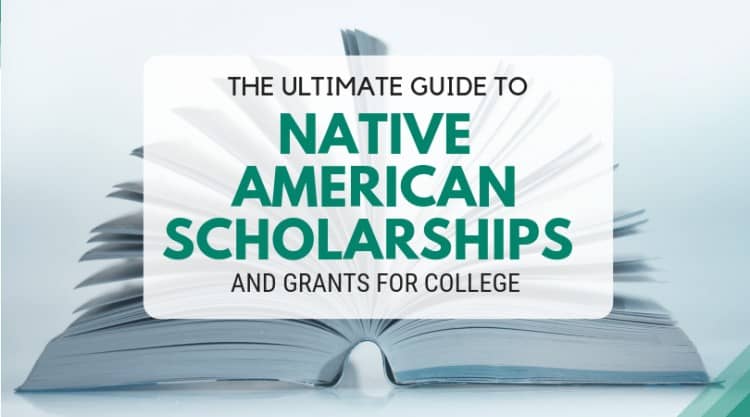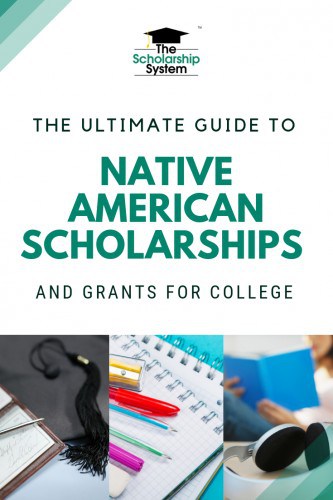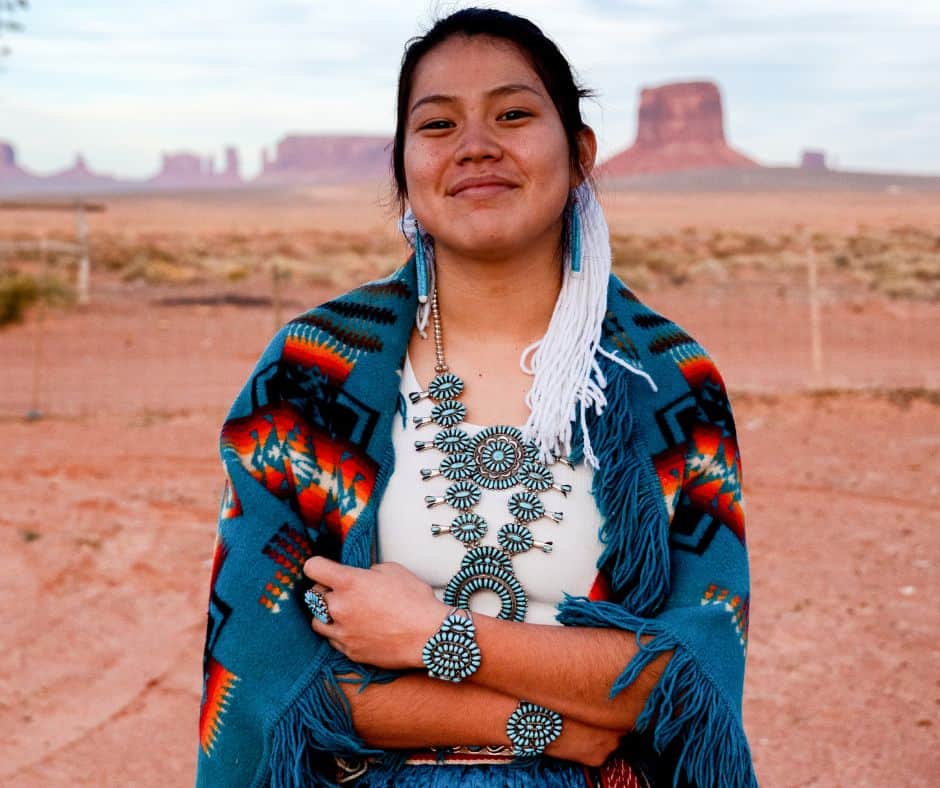Updated on December 12th, 2024
Many financial aid opportunities are only available to people from specific demographics. Native American scholarships and grants aim to support one of the most underrepresented – and often poverty-stricken – groups of prospective college students nationwide, ensuring college is accessible.
Overall, these are excellent opportunities for qualifying high school students. Along with potentially substantial awards, competition is usually lower than college students find with scholarships open to more demographic groups. In some cases, that can make it easier to secure money for college, which may eliminate the need for student loans or other types of debt.
For college students, scholarships can make nearly any school affordable. If you and your student want to learn about scholarships for Native Americans or other types of awards, sign up for our free college scholarship webinar! Take a quick trip over to http://thescholarshipsystem.com/freewebinar to reserve a spot today.
Eligibility for Native American scholarships and grants is based first and foremost on a student’s background or heritage. However, other requirements can also apply. Here’s our ultimate guide to Native American scholarships for college.
Contents
NATIVE AMERICAN SCHOLARSHIPS
Scholarships for Native American students to attend college are fairly common. In fact, numerous groups focus on these minorities entirely, effectively creating a Native American college fund to support educating one of the most underrepresented minority groups in post secondary education in the country.
The Native Forward Scholars Fund, (formerly the American Indian Graduate Center) is a key resource for scholarships and financial support for Native American students.
Since qualifying usually requires tribal membership, it significantly limits the number of students who are deemed eligible. As a result, students who meet the requirements face less competition, which could increase their odds of securing an award (or several).
Here is a list of scholarships for Native American college students:
- AAIA Scholarship Program
- AISES Google Scholarship
- AIS Scholarship Program
- American Indian College Fund Full Circle Scholarship
- American Indian Education Fund Scholarships
- Catching the Dream Scholarship Program
- CSDIW Native American Scholarship
- DAR American Indian Scholarship
- IHS Scholarship Program
- Indigenous Journalists Scholarships
- ITC Truman D. Picard Scholarship
- National Science Foundation Scholarship for Archaeological Training
- Native Vision Johns Hopkins Scholarship Program
- NSCDA American Indian Nurse Scholarship Program
- SAA Native American Scholarships Fund
- Udall Undergraduate Scholarship
- USET Scholarship Fund
Some scholarships for Native American students are also open to Native Alaskans, Native Hawaiians, and other indigenous people. However, many are limited to Native Americans with tribal affiliations, certain blood quantum, or a specific number of generations from someone with a full Native American background.
Along with the opportunities above, students should also explore scholarships through their specific tribe. Many individual tribes operate their own financial aid programs, making them an excellent resource. Plus, competition for those awards may be lower than some of the broader scholarship options listed above, and that could increase a college student’s chances of securing more funding for their education.
PROVING NATIVE AMERICAN ANCESTRY FOR COLLEGE
To qualify, your student will often need documentation proving their Native American heritage meets the criteria. The same goes for tribal memberships, and enrollment criteria can vary from one tribe to the next.
Generally, students must prove they’re part of a federally recognized tribe. According to the Bureau of Indian Affairs (BIA), a federally recognized tribe is “an American Indian or Alaska Native tribal entity that is recognized as having a government-to-government relationship with the United States, with the responsibilities, powers, limitations, and obligations attached to that designation, and is eligible for funding and services from the Bureau of Indian Affairs.” Additionally, qualifying tribes have rights regarding self-government – also known as tribal sovereignty.
In total, there are 574 federally recognized tribes and villages. Having heritage within any of those groups can potentially allow a student to meet the Native American scholarship requirements.
If students don’t have any paperwork outlining their heritage as Native Americans, one place to start is with the Bureau of Indian Affairs. For example, the Certificate of Degree of Indian or Alaska Native Blood Instructions document from the BIA has some excellent information regarding what you need to show in your documentation to qualify. You can also refer to the following BIA document for more information: A Guide to Tracing American Indian and Alaska Native Ancestry.
Generally, the process involves identifying a lineal ancestor who is part of a tribe. Then, students must provide documentation that formally proves their relationship to that person, using vital statistics records or similar official documents.
It’s important to note that a consumer DNA test – like AncentryDNA, 23andMe, or MyHeritage – is insufficient proof of Native American scholarships, grants, or tribal membership. Even if they show college students have a high enough percentage to potentially qualify, they still need to research their lineage to show they’re eligible applicants to pursue these opportunities. However, for students who aren’t certain whether they have enough ancestry to make the research worthwhile, they can be worth doing. That way, students can assess whether their percentage is high enough to dig into the genealogy before doing that research.
ENROLLING IN A TRIBE
Once that research is handled and college students determine they have a direct connection, they can apply to enroll in a tribe. At that point, students must contact the tribe directly to determine the tribal enrollment and membership requirements and follow that specific tribe’s process.
If students aren’t sure where to turn for that step, they can access the BIA Tribal Leaders Directory as a starting point. Within it is contact information for every federally recognized tribe, making it a straightforward way to determine how to reach out and initiate the process.
Many tribes also have websites that contain contact and membership requirement information. As a result, students may be able to get what they need with a simple online search. Some may also publish initial applications and accept submissions through a web portal.
It’s critical to state that applying won’t guarantee a person’s membership in a tribe. As mentioned above, eligibility requirements can vary, and tribes ultimately decide internally. However, students who meet the outlined requirements and provide sufficient documentation have a strong chance, so keep that in mind. Additionally, if they’re denied, tribes may have appeals processes that can give students a second chance if they can gather more evidence to support their case.
The quantum – or percentage of Native American blood or ancestry – a person needs to qualify for a Native American scholarship varies. In some cases, proving any ancestry at all is sufficient. In others, you may need to demonstrate that your student meets a specific minimum, like being at least one-quarter Native American.
Tribal membership requirements relating to blood quantum, like Native American scholarships, also differ from one tribe to the next. Many require at least one-quarter, while others only require one-eighth or one-sixteenth. In some cases, any degree is allowed. That means if you can prove your student is a descendant, no matter how far back, that’s enough to qualify potentially with some tribal groups.
NATIVE AMERICAN COLLEGE GRANTS
Regarding financial aid for college education, grants are less common than scholarships. However, there are Native American grants out there.
Tribal Colleges and Universities (TCUs) play a crucial role in providing culturally supportive educational opportunities and financial aid tailored specifically for American Indian students.
For example, the BIE Higher Education Grant Program specifically focuses on the financial need and making college more affordable for Native American students. Some colleges and universities also have Native American financial assistance programs that include institutional grants and scholarships, such as the IPLP Scholarship Program at the University of Arizona or the Montana University System American Indian Waiver program.
Additionally, many tribes have their own Native American higher education scholarships and grant programs. Tribal membership is usually a requirement, and information is typically available from tribal leadership.
There are also grants available specifically for graduate students, highlighting the financial challenges they face and the support available to help them pursue advanced degrees.
Consequently, undergraduate students interested in this route may need to research the options themselves. In many cases, contacting their tribe is the best way to begin, as tribes usually track various grant opportunities that are available to their members reasonably well.
NATIVE STUDENT LOANS
Student loan opportunities that are limited to specific demographics are fairly rare. However, there are some Native student loan repayment programs out there.
For instance, the Indian Health Service operates a loan repayment program for healthcare workers who commit to two years of service in a qualifying facility. It’s not strictly limited to Native American students or professionals but is open to them.
In most cases, Native American students will use student loan options available to everyone, such as the Stafford Loan program through the Department of Education. Additionally, they can explore private student loans if the need arises.
However, it’s critical to note that student loans involve acquiring debt, and they are often cumbersome to manage if the total amount owed gets high. While there are programs designed to ease the burden on federal student loans – such as the new SAVE plan – private student loans usually have set repayment requirements. As a result, limiting the use of student loans is always best, and if they are necessary, favoring federal student loans over private ones is usually the better choice.
STATE-BASED FINANCIAL AID FOR NATIVE AMERICANS
Some states (or college systems) have separate financial aid programs for local students with Native American ancestry. Membership in a federally recognized tribe in the state is generally a requirement, though some offer financial support to the broader Native American population. State-based financial aid programs often cater to both undergraduate and graduate students, providing opportunities for financial support at different educational levels.
Students can often learn about these opportunities by researching their state’s Indian Affairs agency or department. Additionally, they may find details on a college’s financial aid webpage or through the financial aid office.
Here is a list of some of the available programs that students can explore:
- Alabama Indian Affairs Commission Scholarship
- Kansas Ethnic Minority Scholarship
- Massachusetts Financial Aid for Native Americans
- Michigan Tuition Waiver for Native Americans
- Minnesota Indian Scholarship Program
- Minority Teachers of Illinois Scholarship Program
- Montana University System American Indian Tuition Waiver
- New York State Aid to Native Americans
- University of Arizona Native American Funding
As with Native American scholarships, the Native American college benefits can have unique requirements beyond heritage. For example, some may limit eligibility to college students pursuing specific majors or careers.
As a result, graduate and undergraduate students interested in them need to review the rules carefully to determine if they qualify. Students can also contact the financial aid office for school-based programs to learn more about eligibility and see what’s needed to apply.
NATIVE AMERICAN COLLEGE ADMISSIONS SPECIAL PROGRAMS
Many students wonder if there are Native American college admissions special programs that can increase their odds of admission into various schools. Usually, this is based on the notion that their heritage may qualify them for special consideration since they’re a minority. The issue is that such programs don’t broadly exist and are potentially barred from existing based on current legislation.
First, it’s critical to note that all students must meet minimum eligibility requirements, regardless of their heritage. That means students must have the required GPA, ACT or SAT scores, and other factors colleges deem essential to gain entry. If they fall short, their background usually won’t suddenly make them eligible for admission.
Second, a recent Supreme Court ruling bars universities from factoring in race when making admissions decisions. Such race-conscious diversity efforts were deemed unconstitutional, so all colleges using such programs are having to wind down or revamp them if they were in use.
While this generally impacts specific elite universities – such as Harvard – the most, as it was a means of ensuring diversity, it does limit essentially all colleges’ ability to use such demographic information when making admissions decisions. As a result, that would potentially make Native American college admissions special programs illegal.
Even tribal colleges and universities (TCUs) are predominately open to all types of students. While they classically have a larger percentage of Native American students due to their proximity to tribal lands and programs and cultures focused on the local Native American community, they typically don’t consider heritage when admitting students in a significant way.
However, it’s critical to note that some colleges and universities have special programs for Native Americans; they just aren’t related to admission. Instead, they usually involve Native American college benefits such as substantial tuition and fee waivers.
NATIVE HAWAIIAN SCHOLARSHIPS
There are also scholarship opportunities for Hawaiian natives, and many operate similarly to those focused on Native Americans. These Native Hawaiian scholarships aim to support the Hawaiian community and, in some cases, other Asians or Pacific Islanders.
Whether proof of ancestry is required can vary. However, if it is, Native Hawaiians usually must go through a process similar to what’s necessary for Native American enrolled tribal member affiliation. As a starting point, students can explore the Office of Hawaiian Affairs Hawaiian Registry Program for insights.
As with all scholarship programs, eligibility requirements vary. Students may need more than a suitable heritage to qualify. For example, academic performance requirements, pursuing specific majors, or other factors are often part of the equation.
Here are some of the Native Hawaiian Scholarships that are available:
- Asian & Pacific Islander American Scholarship Fund
- Hawai’i’s Daughters Guild of California Scholarship Program
- HRSA Native Hawaiian Health Scholarship
- Office of Hawaiian Affairs Scholarship Program
- Pauahi Foundation Scholarships
- PIFA Scholarship Program
ALASKA NATIVE SCHOLARSHIPS
Scholarships for Native American high school students to attend college are fairly common. In fact, numerous groups focus on these minorities entirely, effectively creating a Native American college fund to support educating one of the most underrepresented minority groups in the country.
As with various scholarships for Native Americans, the exact eligibility requirements can vary. As a result, students need to review any rules carefully to determine if they qualify before applying.
Here is a list of Native Alaskan scholarships for students to explore:
- Alaska Community Foundation Scholarships
- Alaska Native Tribal Health Consortium Scholarships
- Aluet Foundation Scholarships
- Aqqaluk Trust Scholarships
- Arctic Education Foundation Scholarships
- AVEC Scholarships
- Bristol Bay Native Corporation Scholarship
- Calista Scholarship Program
- Chugach Heritage Foundation Scholarships
- Ciri Foundation Scholarships
- Goldbelt Heritage Scholarships
- Koniag Education Foundation Scholarships
- Mat-Su Health Foundation Scholarships
- Native Forward Scholars Fund
- Old Harbor Scholarship Foundation
- RSM Scholarships
- Sealaska Scholarship
- Sitnasuak Scholarships
Additionally, scholarship programs that focus on minorities are potentially an option. Native Americans and Native Alaskans are often classified as minorities, so programs for minority students that don’t target a specific minority group can be another option.
PROVING ALASKA NATIVE ANCESTRY FOR SCHOLARSHIPS
As with Native American heritage, establishing Alaska Native ancestry is required for many Native Alaskan scholarships. Generally, the process is the same, as it focuses on proving heritage from a federally recognized tribe.
Establishing lineage can require significant research. However, the BIA documents mentioned previously can help guide college students in the right direction.
As with Native American lineage, commercial DNA tests aren’t sufficient for establishing Alaskan Native heritage. Those results alone won’t make a student eligible for Native Alaskan scholarships or other college benefits. Since that’s the case, students must dig deeper to prove their eligibility.
FREQUENTLY ASKED QUESTIONS
Can I go to college for free if I’m Native American?
Yes, you may be able to go to college for free if you’re Native American thanks to scholarships, grants and financial aid programs specifically for Native American students. Many tribes offer financial assistance to their members and there are federal programs like Bureau of Indian Education grants and scholarships. Colleges and universities have also started programs to give tuition assistance or full scholarships to Native American students. Research and apply early to meet all eligibility requirements and deadlines. Talk to your tribe’s education office and your college’s financial aid office to get more information and resources.
What is the difference between a scholarship and a grant?
A scholarship and a grant are both forms of financial aid but they are different. Scholarships are awarded based on merit such as academic achievements, athletic ability or artistic talent and often require a lengthy application process. Grants are need based and are for students who show financial need. They are often provided by governments, institutions or private organizations and focus more on the applicant’s financial situation rather than their achievements. Neither scholarships nor grants need to be repaid so they are great for educational funding.
OTHER SCHOLARSHIP OPPORTUNITIES
It’s important to note that Native Americans aren’t limited to just the scholarships above. Along with awards not focused on a particular demographic, many scholarships for minorities are also opportunities Native Americans can access.
Plus, many don’t consider demographics at all. For example, here is a list of 34 STEM Scholarships to Apply for Now that includes a ton of options that don’t limit eligible applicants by heritage.
If you want to discover how to find Native American student scholarships or other awards and opportunities to help your student graduate debt-free, join our free webinar! You’ll learn a ton about the entire scholarship process, including how to find opportunities, organize documentation, complete applications, write winning essays, and more. Take a trip to https://thescholarshipsystem.com/freewebinar to find out when the next training session is available.









Leave a Reply